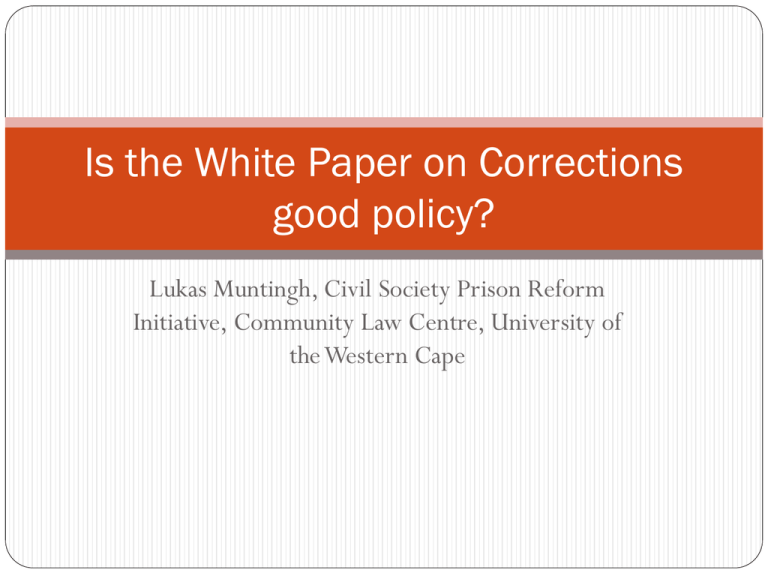
Is the White Paper on Corrections
good policy?
Lukas Muntingh, Civil Society Prison Reform
Initiative, Community Law Centre, University of
the Western Cape
Introduction
The 2005 White Paper on Corrections in South Africa replaced the hastily drafted 1994
White Paper and places “rehabilitation at the centre of all Departmental activities in
partnership with external stakeholders”.
What has been the progress made on the 20-year vision?
Is the White Paper is indeed good and appropriate policy for the South African prison
system?
WP is assessed against the 9 features of modern policy-making – UK government and
work by Bullock, Mountford and Stanley (2001)
The 9 features of modern policy
making
Forward looking
Outward looking
Innovative, flexible and creative
Evidence-based
Inclusive
Joined up
Review progress
Evaluation
Learns lessons
The White Paper
Objectives of the correctional system according to WP:
Implementation of sentences of the courts
Breaking the cycle of crime
Security risk management
Providing an environment for controlled and phased rehabilitation interventions
Providing guidance and support to probationers and parolees within the community
Provision of corrective and development measures to the offender
Reconciliation of the offender with the community
Enhancement of the productive capacity of offenders
Promotion of healthy family relations
Assertion of discipline within the correctional environment
The White Paper
Objectives according to CSA:
Enforcing sentences
Safe and humane detention
Promoting social responsibility
The WP is also replete with descriptions stating that rehabilitation is the core business of
the Department, for example: “The responsibility of the Department of Correctional Services is
first and foremost to correct offending behaviour, in a secure, safe and humane environment, in order
to facilitate the achievement of rehabilitation, and avoidance of recidivism.”
The White Paper
Central to achieving rehabilitation is the development of a “needs-based intervention
plan” for each offender (sentence plan in CSA). The needs-based intervention plan should
cover the following areas:
needs in terms of correcting offending behaviour (Corrections plan);
security needs taking into account the human rights of the individual (Security plan);
needs in terms of the physical and emotional well-being of the offender (Care plan);
education and training needs (Development plan);
needs in terms of allocated physical accommodation (Facilities plan); and
needs in terms of the support required for the successful social reintegration of the
offender (After-Care plan).
Forward looking
The policy-making process results in clearly defined outcomes that the policy is designed to
achieve and takes a long-term view (five years), as needed, based on statistical trends and
informed predictions of social, political, economic and cultural trends and the possible effect
and impact of the policy.
While the White Paper identifies with remarkable frankness a broad range of
problems and consequently identifies the objectives of the correctional system,
these cannot be regarded as clear outcomes. Some are broad statements of intent
(e.g. breaking the cycle of crime), some are definitional descriptions without
articulating an outcome (e.g. Security risk management), and some approach clarity
but fall short (e.g. providing an environment for controlled and phased
rehabilitation interventions).
Superficial reflection on prison population trends (e.g. lifers and children) and no
forecasting.
Unsentenced prisoners removed from the 2009 re-print, yet make up 30% of
population?
20-year view too long – institutional memory lost, leadership changes. Good
practice is 5 year view.
Outward looking
National, regional and international influencing factors are taken account of as well as
experiences from other countries. It also assesses how the policy will be communicated to
the public and stakeholders.
General acknowledgement of IHRL and selective citing of UNSMR ; no
mention of UNCAT
No mention of SA jurisprudence on prisoners
Refers to “international best practice” in general but it is unknown how these
practices were identified and who or what identified them to indeed be
international best practices.
There is an established and growing body on what good practice is i.r.o.
Rehabilitation but these are not reflected on.
DCS did make a considerable effort to communicate the WP but this was not
accompanied by an implementation plan.
Innovative flexible and creative
Flexibility and innovation characterises the policy-making process. Critically examining established
ways of dealing with problems is encouraged as well as developing creative solutions.The process is
open to comments and suggestions of others, and risks are identified and actively managed.
Based on what is contained in the White Paper it is not possible to assess if the policy
making process was “innovative, flexible and creative” and it therefore needs to be
assessed if the White Paper creates an appropriate framework to enable innovation,
flexibility and creativity.
The White Paper is at a sufficiently abstract level to enable innovation, flexibility and
creativity at operational level.
Chapter 13, which deals with external partnerships, established a useful framework for
collaboration between the DCS and civil society service providers. This sector has been
shown to be particularly creative in developing new programmes and approaches to
rehabilitation and should thus be able insert their knowledge and skills into the
Department.
An appropriate forum for interacting with civil society organisations had not been
established yet. It recently came to light that the DCS is planning to remunerate civil
society organisations for services rendered.
Evidence-based
Decisions of and advice to policy makers are based upon the best available evidence from
a wide range of sources, and all key stakeholders are involved at an early stage and
throughout the policy's development. All relevant evidence, including that from specialists,
is available in an accessible and meaningful form to policy makers.
Since the White Paper places rehabilitation at the core of the Department’s
business, it is required that this focus in the White Paper should be based on the
best available evidence and that the approach adopted reflect it accordingly. In
the past 20 to 30 years there has been a considerable amount of research
conducted on ‘what works’ in offender rehabilitation, especially in the US and
Canada. Notable contributions in this regard came from Sherman, Gendreau,
Cullen, Bonta, Andrews, and Ross.
Section 9.6 of the WP identifies the key service delivery areas, with the first
being ‘Corrections’ and states that “the initial focus will be to target the actual
offence for which the person has been convicted and sentenced” . This approach
is not supported by the principles for effective programmes, which make no
mention of the current offence but rather the dynamic criminogenic factors
driving criminal behaviour.
Evidence-based (cont)
The paucity in evidence-based policy-making is further demonstrated in
paragraph 9.7.3 which reads: “Scientific and thorough research into the components of
sentence planning for the various categories of offenders will have to shape the delivery of
appropriate and effective corrections and development programmes in all aspects of the
offender’s life. While rehabilitation is the desired outcome of the work of correctional
services, of which correcting the offending behaviour is the key component, there is much
debate about the components that are required to make up the route to rehabilitation.”
The work done by the above-noted scholars demonstrate that there is indeed
increasing agreement on what works, but also on the components that “make up
the route to rehabilitation”.
No description of costing or cost drivers yet highly reliant on professional skills
for implementation.
Inclusive
The policy-making process involves key stakeholders directly to take account of the impact
on and/or meets the needs of all people directly or indirectly affected by the policy.
The extent to which external stakeholders were brought into the policy-making
process prior to the tabling of the draft in Parliament is unknown. However,
when public hearings were held by the Portfolio Committee on Correctional
Services on the White Paper in early 2004, this was the first time that civil
society stakeholders had sight of the draft White Paper. At an earlier briefing, in
November 2003, by the DCS on the Green Paper (which preceded the White
Paper), the Portfolio Committee expressed concern that there had been
insufficient consultation on the Green Paper. At the public hearings in February
2004, a number of civil society stakeholders expressed their dismay at the
limited time they were afforded to study and comment on the lengthy White
Paper.
Subsequent to the adoption of the White Paper there had been no formal and
broad-based consultations on the implementation of the White Paper.
Joined up
The process takes a holistic view by looking beyond institutional boundaries to the
government's strategic objectives and seeks to establish the ethical, moral and legal base for
policy.There is consideration of the appropriate management and organisational structures
needed to deliver cross-cutting objectives.
The legal basis and legislated mandate for the White Paper are adequately described,
although a more overt focus on international human rights law would have added value.
Reference to now abandoned NCPS
The White Paper does not explicitly identify cross-cutting objectives and this need to be
inferred, such as adherence to human rights standards, effective social integration,
reducing prison overcrowding, and sentencing reform.
It may indeed be concluded that the White Paper’s focus on rehabilitation is so intense
that it results in tunnel vision; losing sight of the other two objectives of the correctional
system, namely implementing the sentences imposed by the courts and ensuring safe and
humane custody. It is in particular the omission of an overt human rights-based approach
that is of concern and this omission is increasingly evidenced by extensive and often gross
human rights violations after 2004.
Review
Existing and established policy is constantly reviewed to ensure it is really dealing with problems it
was designed to solve, taking account of associated effects elsewhere.
The White Paper did not establish a review mechanism for itself, nor did it set at policy
level the requirements for a performance monitoring system. Department’s
performance is overseen by Parliament (through the Portfolio Committee) and by civil
society actors
The overall performance of the DCS since (and prior to) the adoption of the White
Paper has not been satisfactory as have been evidenced by successive qualified financial
audits, critical reports by the JICS on the treatment of prisoners, low to moderate target
setting in respect of which delivery was often not compliant, critique by civil society, and
continued incidents (and allegations) of corruption and maladministration.
AG 2010: “The accounting officer did not ensure that the department has and maintains an
effective, efficient and transparent system and internal controls regarding performance management,
which describe and represent how the institution’s processes of performance planning, monitoring,
measurement, review and reporting will be conducted, organised and managed, as required in terms
of section 38(1) (a) (i) and (b) of the PFMA” (Public Finance Management Act).
The current situation is thus that the available performance information is of such
questionable validity that it would be risky to review policy based on it.
Evaluation
Systematic evaluation of the effectiveness of policy is built into the policy making process.
The White Paper (in paragraph 9.18) narrows the scope of evaluation to measuring
success in respect of rehabilitation and, in doing so, sidelines the other goals of the White
Paper. Importantly, compliance with the Correctional Services Act is not emphasised in
the White Paper with particular emphasis on meeting the minimum standards of humane
detention and implementing the sentences imposed by the courts. Moreover, it identifies
recidivism as the indicator of success and this is problematic.
Beck – “it is a fruit salad concept” and poses 3 questions:
What is counted as recidivism? For example, do we count arrests, prosecutions,
convictions, custodial, and non-custodial sentences? Do we count all offences, from
parole violations and consensual crimes to serious offences?
What is the time-frame of measurement? Do we measure, for example, at one year
for all offences, or do we measure violent and sex offences over longer periods?
What is the basis for making sense of the data? With recidivism data it is crucial to
compare “apples with apples”.
Evaluation
In short, using recidivism as an indicator of rehabilitation and reintegration
success is fraught with difficulties and highly dependent on accurate recording
and reporting. When information systems in the criminal justice system are not
set up to and do not function in pursuit of this objective, the results will be
questionable. Rehabilitation and reintegration is a multi-layered process with
too complex an interaction of variables for it to be measured by one indicator
that is, in essence, subject to a range of other intermediaries and at best can
show us only part of the picture.
Learns lessons
Learns from experience of what works and what does not.
In the preceding it has been shown that the inadequate performance
management systems of the DCS does not meet the requirement relating to the
review of policies. This means that the current systems are not collecting the
right information in a reliable manner that would yield valid answers. It was
furthermore shown that the White Paper defined evaluation in a narrow
manner, emphasising rehabilitation and identifying recidivism as the indicator in
this regard. The limitations in this regard have been noted. These two
shortcomings place severe constraints on the extent to which lessons can be
learnt from the implementation process. Moreover, a review of the post-2005
annual reports as well as the comments from the Portfolio Committee on
Correctional Services, the annual reports of the JICS and the AG indicate a
remarkable consistency and repetition in the problems being faced by the
Department.
Conclusion
The above has shown that the White Paper falls short in substantive ways of the
requirements of modern policy-making. Five years after its adoption, results in
respect of the rehabilitation vision remain unknown and elusive. The JICS
estimates that only 15% of sentenced prisoners are involved in some form of
treatment programmes and labour. For the overwhelming majority of sentenced
prisoners the White Paper has not lived up to expectations. While it may be
argued that to re-invent the South African prison system is a goal to be achieved
within five years, it should also be asked if the White Paper provides the correct
response (i.e. rehabilitation) to the challenges faced by the prison system.
Conclusion
The main challenges to the prison system are defined in the White Paper as
being overcrowding; the state of DCS infrastructure; institutional “prison
culture”; corruption; training for the new paradigm, and “structuring [the
department] for the new paradigm”. Conspicuously absent from this list are
human rights violations and an explicit mention of meeting the minimum
standards of humane detention. Presumably the latter can be read into
challenges around infrastructure and overcrowding. These are significant
challenges, yet the White Paper gives scant attention to human rights issues and
deals in far more detail with rehabilitation. Moreover, compliance with the
Correctional Services Act is not a stated outcome of the White Paper, although
several selected references to the Act are made. It is therefore not surprising
that the DCS finds itself continuously in litigation.
Conclusion
The White Paper says little about implementation and while this is not a
fundamental shortcoming, it should have articulated the pre-conditions or
requirements for implementation. If rehabilitation is indeed the core business of
the Department, the White Paper should have articulated in more tangible
terms what is in fact required with reference to staff skills, required staff
categories, and infrastructure. After five years it remains unknown to what
extent the necessary pre-conditions for implementation have been met.
In view of the above, it is required to re-visit the White Paper and pay particular
attention to compliance with the Correctional Services Act; ensuring that
knowledge informs the policy development process and that there is extensive
consultation with stakeholders.








